display CADILLAC DEVILLE 1996 7.G Service Manual
[x] Cancel search | Manufacturer: CADILLAC, Model Year: 1996, Model line: DEVILLE, Model: CADILLAC DEVILLE 1996 7.GPages: 354, PDF Size: 20.32 MB
Page 178 of 354
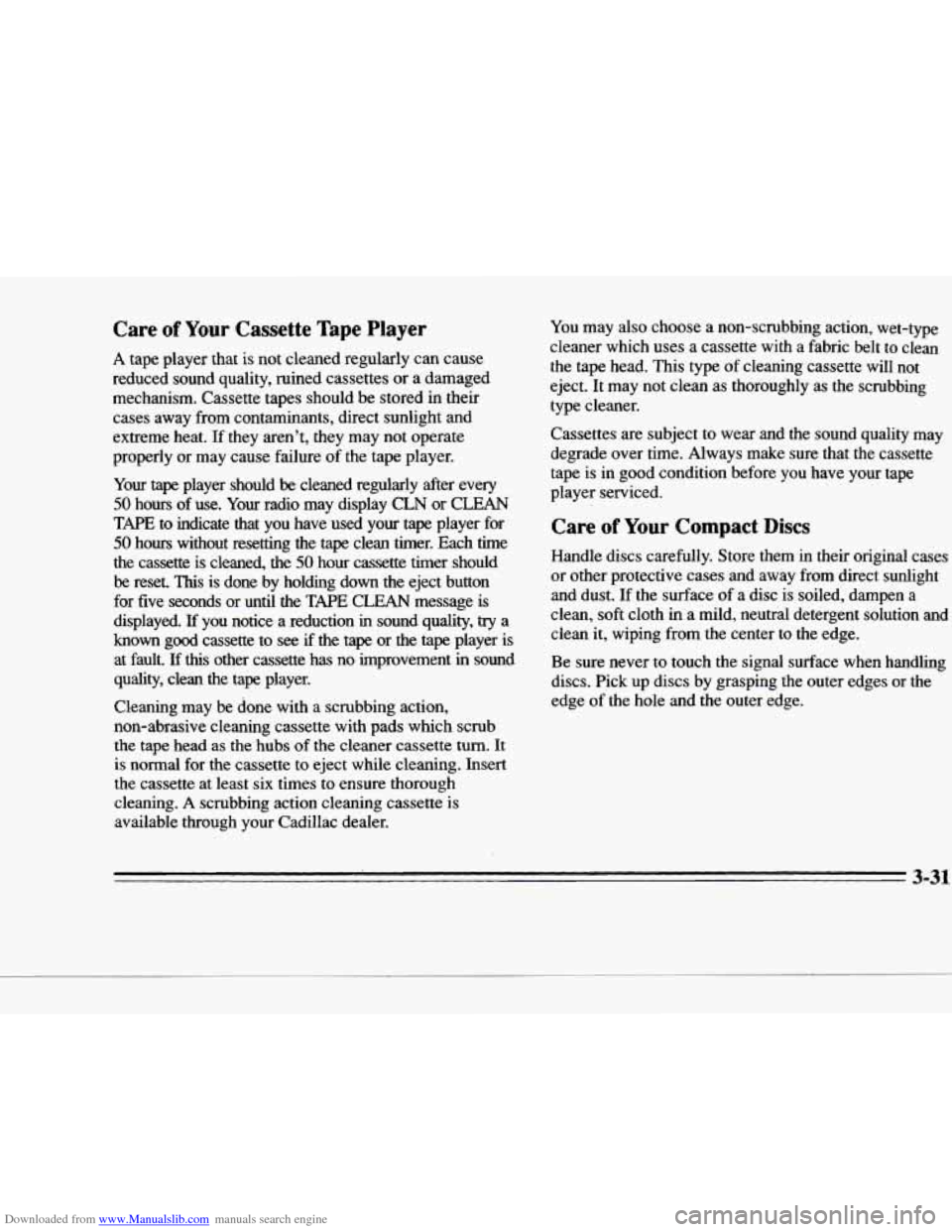
Downloaded from www.Manualslib.com manuals search engine c
c
c
Care of Your Cassette Tape Player
A tape player that is not cleaned regularly can cause
reduced sound quality, ruined cassettes or a damaged
mechanism. Cassette tapes should be stored in their cases away from contaminants, direct sunlight and
extreme heat.
If they aren’t, they may not operate
properly
or may cause failure of the tape player.
Your
tape player should be cleaned regularly after every
50 hours of use. Your radio may display CLN or CLEAN
TAPE to indicate that you have used your tape player for
50 hours without resetting the tape clean timer. Each time
the cassette
is cleaned, the 50 hour cassette timer should
be reset. This is done by holding down the eject button
for five seconds or until the
TAPE CLEAN message is
displayed. If you notice a reduction in sound quality, try a
known good cassette to
see if the tape or the tape player is
at fault.
If this other cassette has no improvement in sound
quality, clean the tape player.
Cleaning may be done with a scrubbing action,
non-abrasive cleaning cassette with pads which scrub
the
tape head as the hubs of the cleaner cassette turn. It
is normal for the cassette
to eject while cleaning. Insert
the cassette at least six times to ensure thorough
cleaning.
A scrubbing action cleaning cassette is
available through your Cadillac dealer. You may
also choose a non-scrubbing action, wet-tyw
cleaner which uses a cassette with a fabric belt
to clean
the tape head. This type of cleaning cassette will not
eject.
It may not clean as thoroughly as the scrubbing
type cleaner.
Cassettes are subject
to wear and the sound quality may
degrade over time. Always
make sure that the cassette
tape is in good condition before you have your tape
player serviced.
Care of Your Compact Discs
Handle discs carefully. Store them in their original cases
or other protective cases and away from direct sunlight and dust. If the surface of a disc is soiled, dampen
a
clean, soft cloth in a mild, neutral detergent solution and
clean it, wiping from the center
to the edge.
Be sure never to touch the signal surface when handling
discs. Pick up discs
by grasping the outer edges or the
edge
of the hole and the outer edge.
3-31
Page 189 of 354
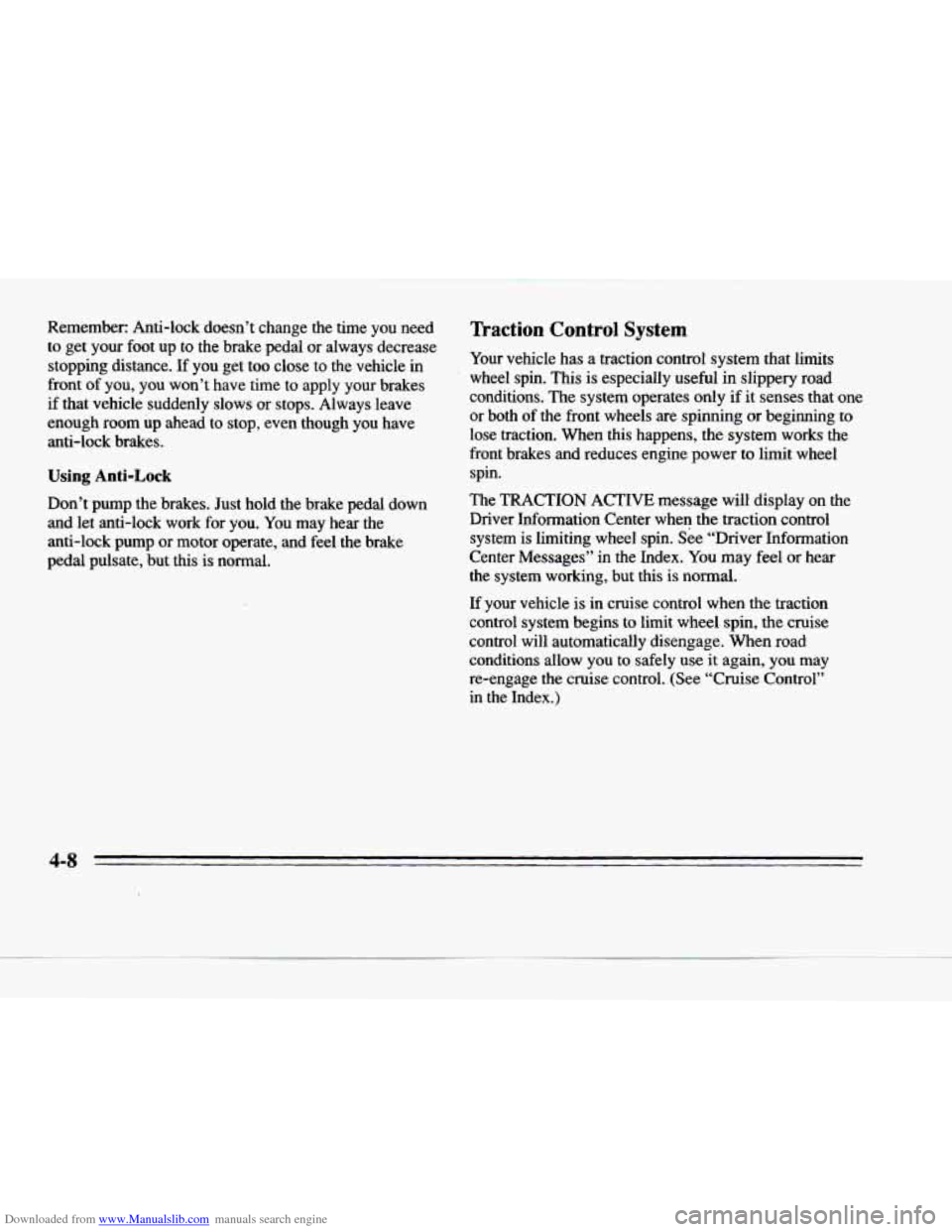
Downloaded from www.Manualslib.com manuals search engine Remember: Anti-lock doesn’t change the time you need
to get your foot
up to the brake pedal or always decrease
stopping distance. If you get too close
to the vehicle in
front of you, you won’t have time to apply your brakes
if that vehicle suddenly slows or stops. Always leave
enough room
up ahead to stop, even though you have
anti-lock brakes.
Using Anti-Lock
Don’t pump the brakes. Just hold the brake pedal down
and let anti-lock work
for you. You may hear the
anti-lock
pump or motor operate, and feel the brake
pedal pulsate, but this is normal.
Traction Control System
Your vehicle has a traction control system that limits
wheel spin. This is especially useful in slippery road
conditions. The system operates only if it senses that one
or both of the front wheels are spinning
or beginning to
lose traction. When this happens, the system works
the
front brakes and reduces engine power to limit wheel
spin.
The
TRACTION ACTIVE message will display on the
Driver Information Center when the traction control system is limiting wheel spin.
See “Driver Information
Center Messages”
in the Index. You may feel or hear
the system working, but this
is normal.
If your vehicle
is in cruise control when the traction
control system begins to limit wheel spin, the cruise
control will automatically disengage. When road conditions allow you
to safely use it again, you may
re-engage the cruise control. (See “Cruise Control”
in the Index.)
1
4-8
Page 190 of 354
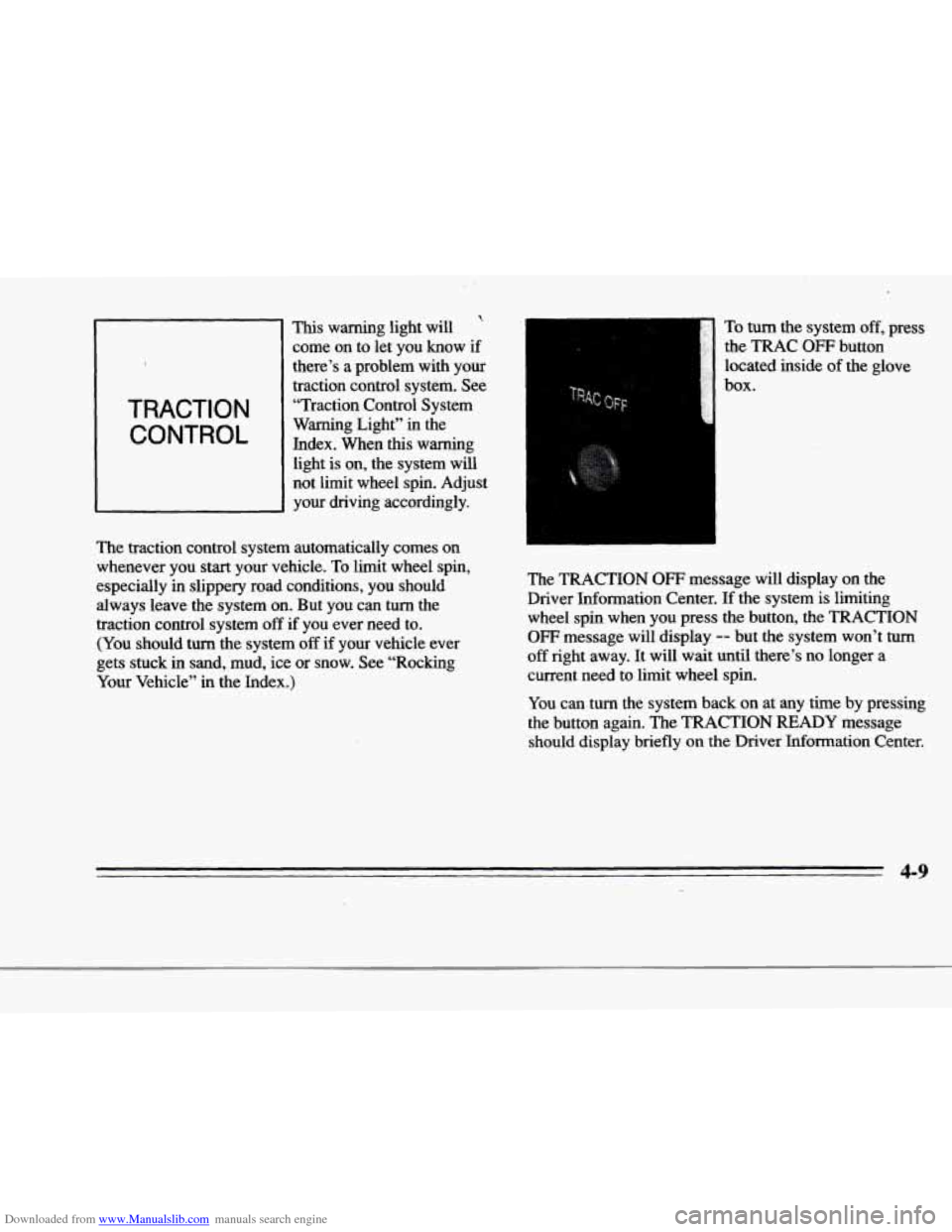
Downloaded from www.Manualslib.com manuals search engine . <.”’. ’ .:, . -. -. .
r
r
r
TRACTION
CONTROL
This warning light will
come on to let you know
if
there’s a problem with your
traction control system. See
“Traction Control System
Warning Light” in the
Index. When this warning
light is on, the system will
not limit wheel spin. Adjust your driving accordingly.
I
r
r
r
The traction control system automatically comes on
whenever you
start your vehicle. To limit wheel spin,
especially
in slippery road conditions, you should
always leave the system on.
But you can turn the
traction control system off
if you ever need to.
(You should turn the system
off if your vehicle ever
gets stuck
in sand, mud, ice or snow. See “Rocking
Your Vehicle” in the Index.)
r
r
To turn the system off, press
the
TRAC OFF button
located inside of the glove
box.
The TRACTION OFF message will display on the
Driver Information Center. If the system
is limiting
wheel spin when you press the button, the TRACTION
OFF message will display -- but the system won’t turn
off right away. It will wait until there’s no longer a
current need to limit
wheel spin.
You can
turn the system back on at any time by pressing
the button again. The TRACTION
READY message
should display briefly
on the Driver Information Center.
4-9
Page 238 of 354
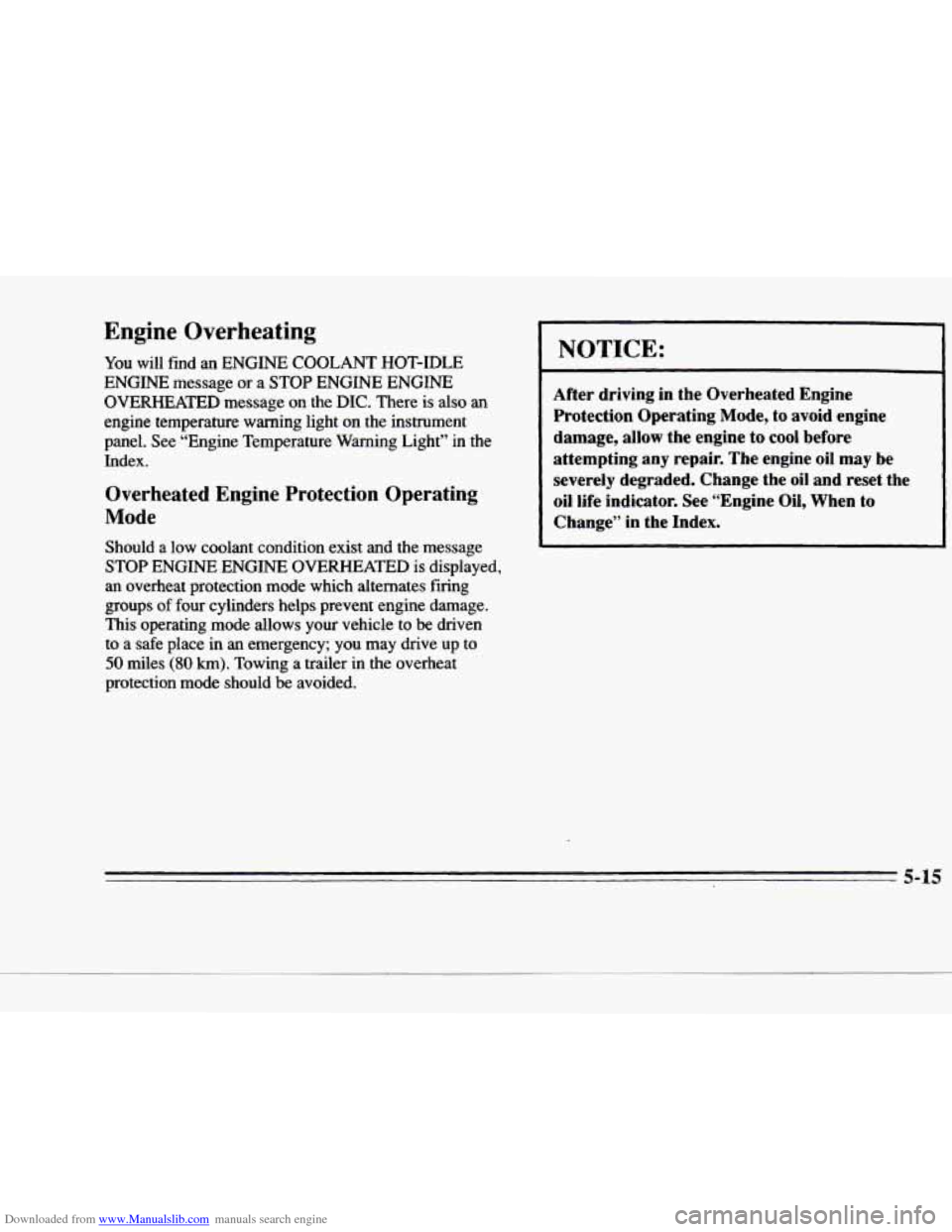
Downloaded from www.Manualslib.com manuals search engine Engine Overheating
You will find an ENGINE COOLANT HOT-IDLE
ENGINE message
or a STOP ENGINE ENGINE
OVERHEATED message on the DIC. There is also an
engine temperature warning light
on the instrument
panel. See “Engine Temperature Warning Light” in the
Index.
Overheated Engine Protection Operating
Mode
Y
Should a low coolant condition exist and the message
STOP ENGINE
ENGINE OVERHEATED is displayed,
an overheat protection mode which alternates firing
groups
of four cylinders helps prevent engine damage.
This operating mode
allows your vehicle to be driven
to a safe place in
an emergency; you may drive up to
50 miles (80 km). Towing a trailer in the overheat
protection mode should be avoided.
I NOTICE:
After driving in the Overheated Engine
Protection Operating Mode,
to avoid engine
damage, allow the engine to cool before
attempting any repair. The engine oil may be
severely degraded. Change the
oil and reset the
oil life indicator. See “Engine Oil, When to
~ Change” in the Index.
P
Page 270 of 354
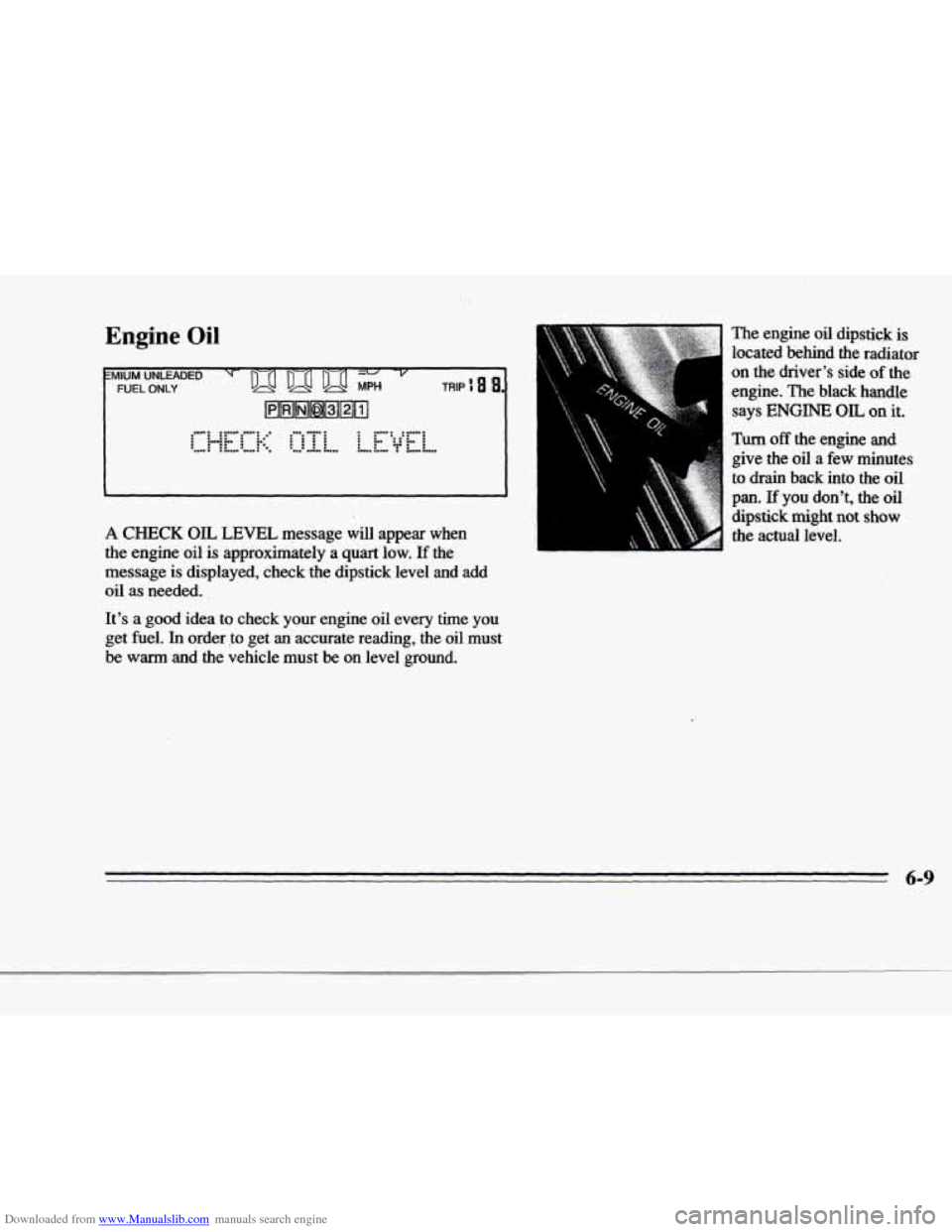
Downloaded from www.Manualslib.com manuals search engine f
r
r
f
r
Engine Oil
.-: ::U" ?... . U. : . ... . .. :::: : :.. :: %. : . . T' .. . . . -. .-. . . ... . . .""." . : ::: : ?a. :::: .. .U. .... "a". . ". UI..... -.-. . L.L
A CHECK OIL LEVEL message will appear when
the engine oil
is approximately a quart low. If the
message
is displayed, check the dipstick level and add
oil
as needed.
It's a good idea to check your engine oil every time you
get fuel.
In order to get an accurate reading, the oil must
be
warm and the vehicle must be on level ground. The engine oil dipstick
is
located behind
the radiator
on the driver's side of the
engine. The black handle
says ENGINE OIL on it.
Turn off the engine and
give the oil a few minutes
to
drain back into the oil
pan. If you don't, the oil
dipstick
might not show
the actual level.
6-9
Page 274 of 354
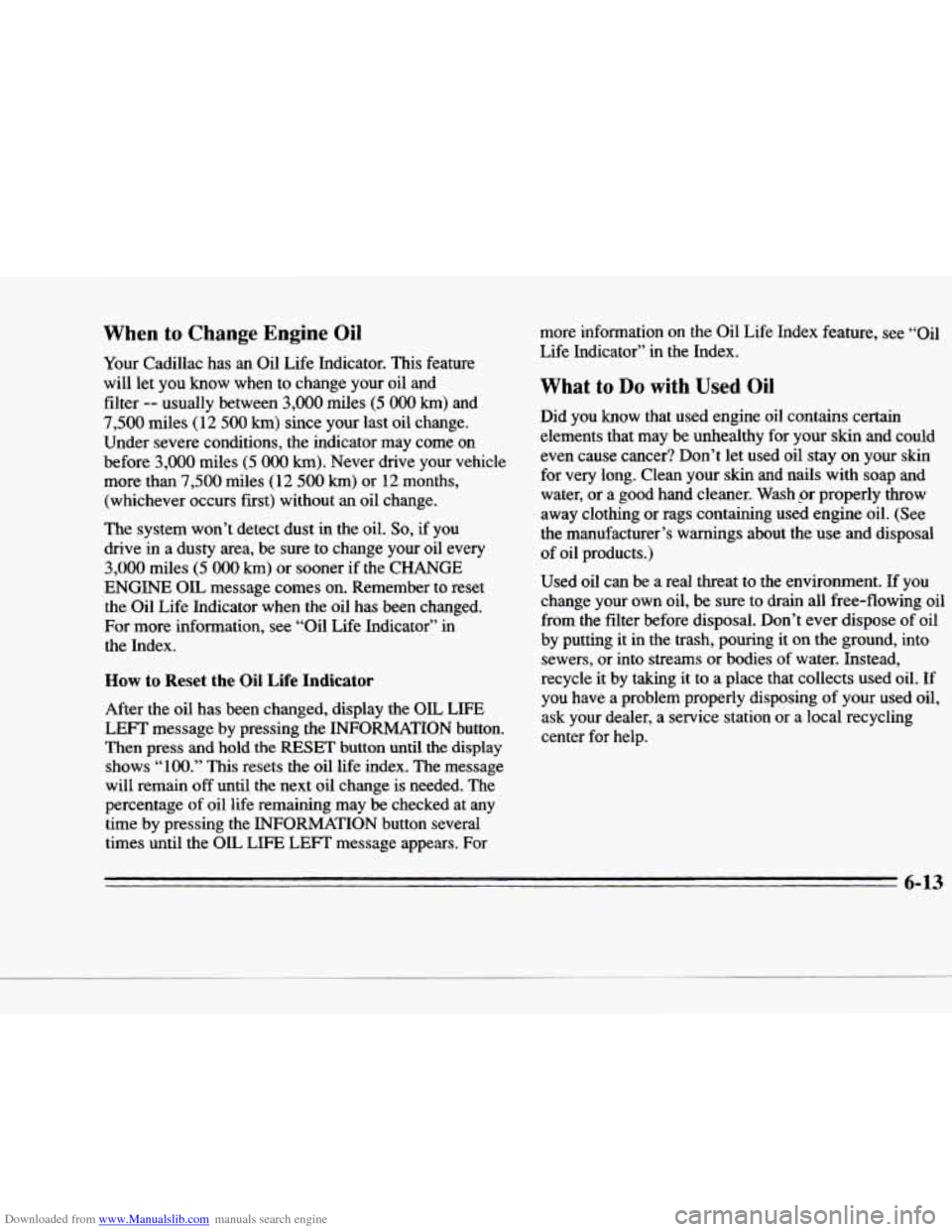
Downloaded from www.Manualslib.com manuals search engine CI
c-
c
When to Change Engine Oil
Your Cadillac has an Oil Life Indicator. This feature
will let you know when to change your oil and
filter
-- usually between 3,000 miles (5 000 km) and
7,500 miles (12 500 km) since your last oil change.
Under severe conditions, the indicator may come on
before
3,000 miles (5 OOO km). Never drive your vehicle
more than
7,500 miles (12 500 km) or 12 months,
(whichever occurs first) without an oil change.
The system won’t detect dust in the oil.
So, if you
drive in a dusty area, be sure to change your oil every
3,000 miles (5 000 km) or sooner if the CHANGE
ENGINE OIL message comes on. Remember to reset
the
Oil Life Indicator when the oil has been changed.
For more information, see “Oil Life Indicator”
in
the Index.
How to Reset the Oil Life Indicator
After the oil has been changed, display the OIL LIFE
LEFT message by pressing the INFORMATION button.
Then press and hold the RESET button until the display
shows
“100.” This resets the oil life index. The message
will remain off until the next oil change is needed. The
percentage of oil life remaining may be checked at any
time by pressing the INFORMATION button several
times until the
OIL LIFE LEFT message appears. For more information
on the Oil Life Index
feature, see “oil
Life Indicator” in the Index.
What to Do with Used Oil
Did you know that used engine oil contains certain
elements that may be unhealthy for your skin and could
even cause cancer? Don’t let used oil stay
on your skin
for very long. Clean your skin and nails with soap and
water, or a good hand cleaner. Wash
;or properly throw
away clothing
or rags containing used engine oil. (See
the manufacturer’s warnings about the use
and disposal
of oil products.)
Used oil can be a real threat to the environment. If you
change your own oil, be sure to drain
all free-flowing oil
from the filter before disposal. Don’t ever dispose of oil
by putting it in the trash, pouring it on the ground, into
sewers, or into streams or bodies of water. Instead,
recycle
it by taking it to a place that collects used oil. If
you have a problem properly disposing
of your used oil,
ask your dealer, a service station or a local recycling
center for help.
6-13
Page 280 of 354
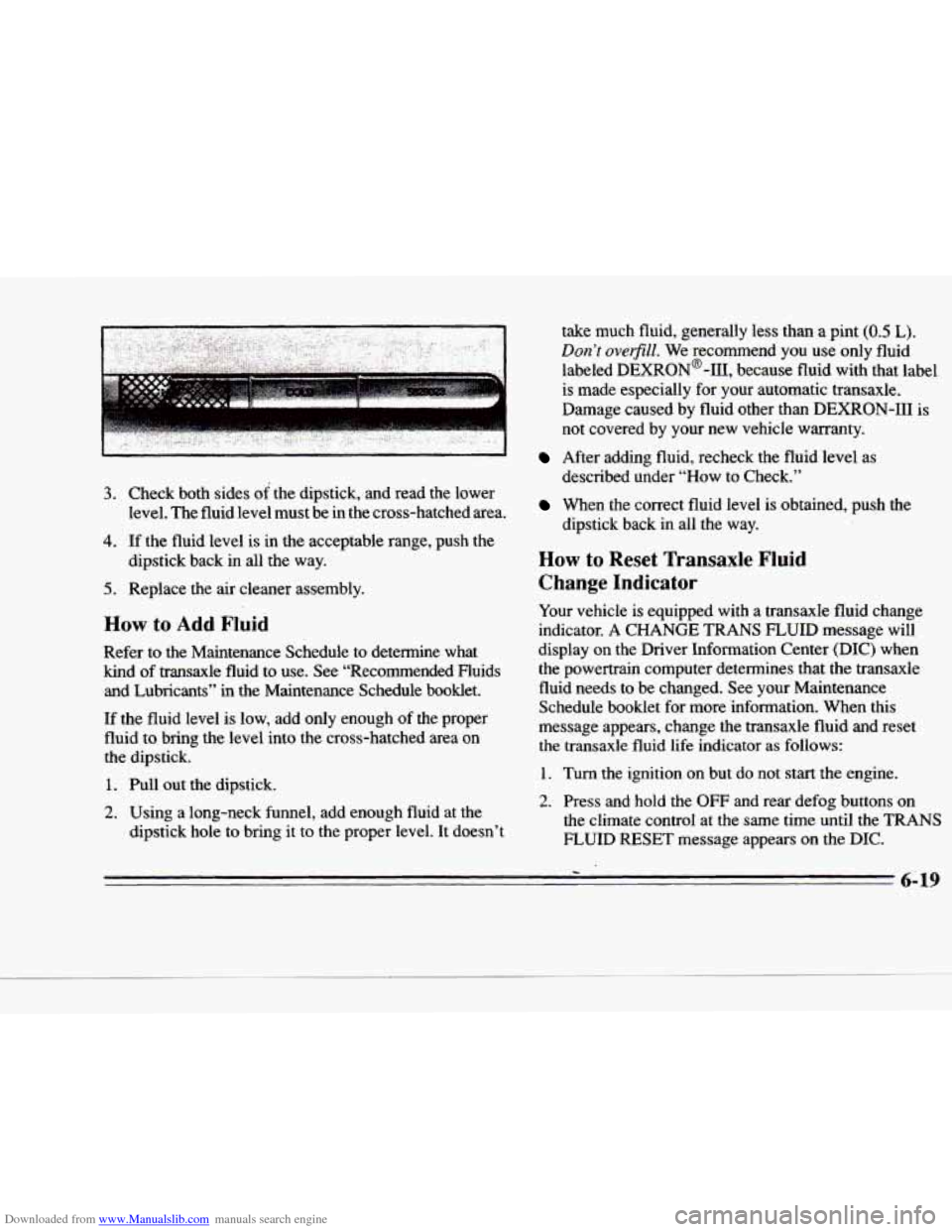
Downloaded from www.Manualslib.com manuals search engine 3. Check both sides of the dipstick, and read the lower
level. The fluid level must be
in the cross-hatched area.
4. If the fluid level is in the acceptable range, push the
dipstick back
in all the way.
5. Replace the air cleaner assembly.
How to Add Fluid
Refer to the Maintenance Schedule to determine what
kind of transaxle fluid to use. See “Recommended Fluids
and Lubricants”
in the Maintenance Schedule booklet.
If the fluid level is low, add only enough of the proper
fluid
to bring the level into the cross-hatched area on
the dipstick.
1. Pull out the dipstick.
2. Using a long-neck funnel, add enough fluid at the
dipstick hole to bring
it to the proper level. It doesn’t take
much fluid, generally less than a pint (0.5 L).
Don’t oveflll. We
recommend you use only fluid
labeled
DEXRON@-111, because fluid with that label
is made especially for your automatic transaxle.
Damage caused by fluid other
than DEXRON-I11 is
not covered by your new vehicle warranty.
After adding fluid, recheck the fluid level as
described under “How to Check.”
When the correct fluid level is obtained, push the
dipstick back in all the way.
How to Reset Transaxle Fluid
Change Indicator
Your vehicle is equipped with a transaxle fluid change
indicator.
A CHANGE TRANS FLUID message will
display on the Driver Information Center (DIC) when
the powertrain computer determines that the transaxle
fluid needs to be changed. See your Maintenance Schedule booklet for more information. When this
message appears, change the transaxle fluid and reset
the transaxle fluid life indicator as
follows:
1. Turn the ignition on but do not start the engine.
2. Press and hold the OFF and rear defog buttons on
the climate control at the same time until the
TRANS
FLUID RESET message appears on the DIC.
z
6-19